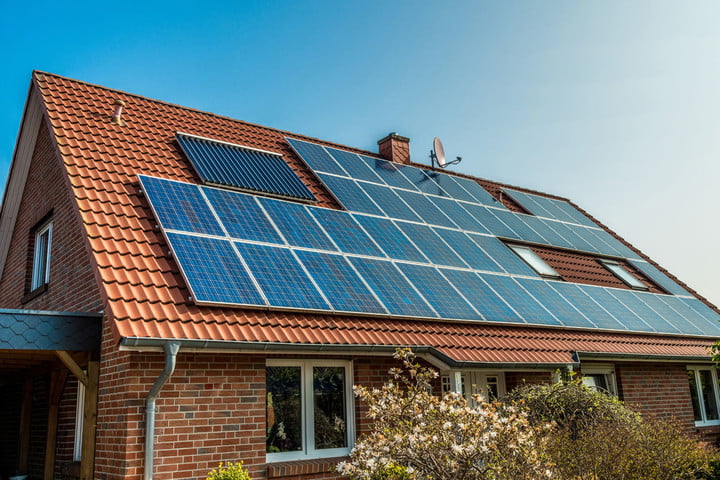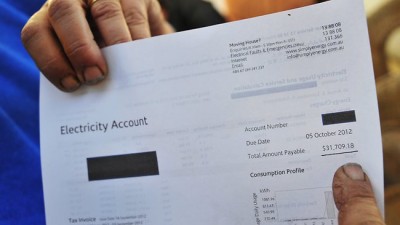Electricity generation started off as an extension of science. These days, it’s all about vanity and virtue signalling. Not least those millions of shiny solar panels, which we’ve all helped subsidise – to allow our neighbours to bask in their own virtuous glow.
At the theoretical level – when the sun is up and the sky is cloud free – solar panels are generating electricity around 6.5 hours a day (on average). During their most virtuous cycle, they’re dispatching power back into the grid, and reducing their owner’s power bills (attracting feed in tariffs multiples greater than the value of the electricity itself – initially some states were paying figures in the order of $540 per MWh – coal-fired power costs less than $40).
Those without panels pick up the tab for the subsidies gifted to their neighbours (whether in the form of feed in tariffs or renewable energy certificates), as well as the network costs that allow the virtuous to dispatch when the sun is in the right quarter, and to receive electricity from the grid, when the sky clouds up or the sun sets.
The ‘risk’ of sunset and cloudy weather is offset by their ability to draw power from the grid, the cost of providing insurance against that ‘risk’ is covered by those who pay full tote odds for their electricity, and with it carry the entire network costs. Solar panel owners only pay network costs when they’re drawing from the grid.
But these matters are mere nitpicking about the costs of an enormous middle-class welfare scheme.
Households’ $2bn hit for solar roof panel subsidies
The Australian
Perry Williams
19 February 2019
Households will pay nearly $2 billion for rooftop solar installation subsidies this year, costing every home nearly $200 and threatening to derail Scott Morrison’s pledge to cut power bills.
The cost of the federal Small-scale Renewable Energy Scheme (SRES) and state-based rebates combined is forecast to rise by 45 per cent from $1.2bn last year to $1.74bn this year.
Consumers are flocking to solar power, enticed by cheaper costs and rebates either under way or pledged in Victoria, South Australia and NSW.
Analysis by renewables trader Demand Manager reveals the annual impost for every household for the subsidy is forecast to soar from $134 last year to $195 this year. The cost of the subsidy is added to all electricity bills.
The subsidy hike — on top of already high electricity prices — will intensify pressure on the government to scrap the scheme as it battles to deliver on tariff cuts for consumers ahead of a federal election due in May. The subsidy program is currently scheduled to be phased out by 2030.
Demand Manager owner Jeffery Bye said: “If left unchecked, electricity consumers will be hit with an increase of between $360 million and $540m in the cost of the SRES starting January 1, 2019. Far from subsidies for renewable energy decreasing and Mr (Angus) Taylor being the ‘minister for getting electricity prices down’, it would appear the solar subsidy cost item on electricity bills will be increasing markedly in 2019.”
The Prime Minister was last week forced to shelve the government’s signature “big stick” divestment legislation to deal with market misconduct by energy companies, sparking accusations by Labor that the Coalition no longer has an energy policy. The move followed the Coalition’s abandonment of its national energy guarantee, and left the government’s plan to underwrite new “firm” power generation as its only big-ticket energy policy on the table for implementation before the election.
More than two million Australians have solar installed in their homes. Capacity is growing at 50 per cent a year as consumers seek to capitalise on the rapidly falling cost of the clean energy technology.
However, analysis of the cost of small-scale technology certificates, which are handed to consumers installing solar panels and then bought back by electricity retailers, shows a soaring cost for all power users. Origin Energy revealed last year that the government’s SRES and state-based solar feed-in tariffs accounted for up to 15 per cent of bill charges.
Mr Taylor, the Energy Minister, said the cost of small-scale technology certificates — created to increase the incentive to install rooftop solar — was just 3 per cent of an average household bill. He said the country’s large generator retailers such as Origin, AGL Energy and EnergyAustralia were responsible for a much bigger portion of power prices.
“The big cost is the profits being taken by the big energy companies in the wholesale market, without innovation or new products, and it is time for them to deliver a fairer deal for their customers,” Mr Taylor said.
“According to the Australian Energy Market Commission, the small-scale technology certificate cost is less than 3 per cent of the bill, whereas 46 per cent is going to the big generator retailers.”
The solar boom is partly being driven by state schemes. Victorians are able to install solar panels for about half the usual price under a $1bn-plus Andrews government scheme, while NSW Labor has announced a plan for 500,000 households to install the renewable technology as part of a capped rebate program.
The Australian Competition & Consumer Commission savaged the subsidy last year in its blueprint to reset the national electricity market, arguing that government support for household solar had been well-intended but misguided. Solar schemes were too generous, unfairly disadvantaged lower-income households and had failed to adjust to the changing economics of household solar, it said. Rooftop solar subsidies should be axed and the states should take on the cost of “excessively generous” solar feed-in tariffs to ease the burden of green power schemes the ACCC estimated cost households up to $170 a year.
Consultancy Deloitte says that with solar and wind power competing in price and performance terms with fossil-fuel sources of generation, the clean-energy industry should move on from any ties to subsidies.
The Clean Energy Council said the government should maintain the SRES as it was “one of the few direct ways that households and businesses can take control to reduce their power bills”.
The Australian
Typical twaddle from Deloitte and the CEC.
On a breathless 40°C February evening, wind and solar doesn’t throw up much ‘competition’, at all.
Instead, households are being powered by coal, gas and hydro, in that order. That’s, of course, if they haven’t already been unceremoniously cut from the grid, as 200,000 Victorians were a few weeks back, following a sudden collapse in wind power output during a brief heatwave. South Australians know the drill, all too well (see above).
As to the self-interested guff pitched up by the CEC, we’ll hand over to JoNova for a little detailed analysis.
Solar subsidy death spiral: $2 billion in Australia, rising 50% pa as electricity prices rocket
Jo Nova Blog
JoNova
20 February 2019
A few Australians are just beginning to realise that they are paying for their neighbour’s solar panel. As news spreads, the shine of good-citizen-solar is going to tarnish fast, but it is going to take a concerted campaign to spread the word.
In one corner are 2 million households which have solar PV and thought they paid for it themselves. In the other corner are 7.5 million households which have exorbitant electricity bills. And in every corner and all across the spectrum is mass confusion thanks to the mass media. The fog of advertisements disguised as “news” means if you ask a dumb-enough-question 70% of Australians will say they want the government to set a high RET target to make electricity cheaper. It’s almost like 2 out of 3 people think we need the government to force us to buy cheap stuff, because everyone would buy the “expensive” planet-killing volts if we only had the choice. Doh.
That’s $200 per household (and the rest!) added to the electricity bill in 2019
This is just the direct SRES (Small Renewable Energy Scheme) cost. It doesn’t cover the burden of stabilizing the grid, of covering the cost of baseload power sitting around waiting for when solar users need it. Unreliable power makes the whole system less efficient, costs go up and all the cheap electricity generators have to charge higher prices too (at least, the ones it doesn’t drive out of business). Then there are the price spikes — so wild they make these subsidies look cheap.
Households’ $2bn hit for solar roof panel subsidies
Perry Williams, The Australian
Households will pay nearly $2 billion for rooftop solar installation subsidies this year, costing every home nearly $200 and threatening to derail Scott Morrison’s pledge to cut power bills.
The cost of the federal Small-scale Renewable Energy Scheme (SRES) and state-based rebates combined is forecast to rise by 45 per cent from $1.2bn last year to $1.74bn this year.
However, analysis of the cost of small-scale technology certificates, which are handed to consumers installing solar panels and then bought back by electricity retailers, shows a soaring cost for all power users.
How’s this for confusion?
Energy companies say the subsidy is 15% of the bill, but the Minister says it is just 3%. We don’t even know what the cost is. Therein lies a free-market disaster. How is anyone supposed to make sensible decisions?
Origin Energy revealed last year that the government’s SRES and state-based solar feed-in tariffs accounted for up to 15 per cent of bill charges.
Mr Taylor, the Energy Minister, said the cost of small-scale technology certificates — created to increase the incentive to install rooftop solar — was just 3 per cent of an average household bill.
Big energy blames big government and big government blames the big energy companies and in a way they’re both right. The big energy companies are playing the market for profits, but big government is screwing the people for power — selling “green electrons” at the election to win seats.
The Liberals are tossing away their best proven election winning advantage. They won’t win votes by aiming for the empty dead centre. The killer comments and lines are left on the cutting room floor.
They can’t show what fools the Labor Green candidates are while they try to be better managed fools themselves.
Just call it quits on the Solar PV subsidy — save householders $200 this year, and even more the year after that.
But read the comments at The Australian. Even at the most informed masthead in the nation many people have no clue.
Sawdust
I pay 28c per kWh for electricity I use from the grid. I get 11c per kWh for electricity my solar panels feed into the grid. Tell me again how I am costing other users money?
The only clever thing about renewable energy is the way the true cost is hidden.
Jo Nova Blog




Reblogged this on ajmarciniak.
Reblogged this on "Mothers Against Wind Turbines™" Phoenix Rising….
As long as they keep those coal fired generators running for the 6.5 hours when I am powering the street with my solar panels so I will have power when the sun sets behind those mountains, who cares. It all works, the Lawyers and politicians have done a very admirable job of changing the old reliable cheap coal fired generation to an absolute dog’s breakfast of a mad hatters tea party of expensive unreliable power generation. You have to take your hat off to all these highly paid Morons.